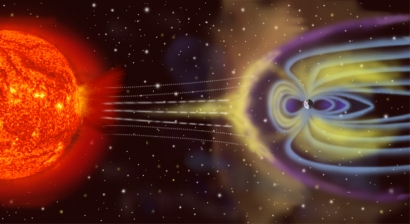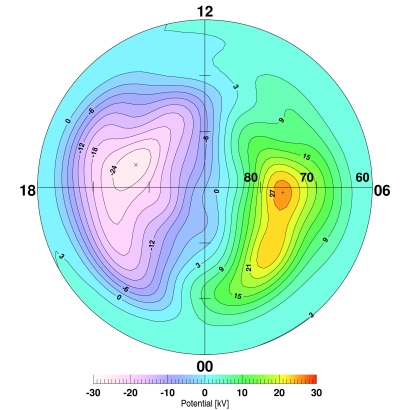The Cluster mission, which is actually four spacecraft, launched in 2000, is designed to study small-scale plasma structures and processes.
A convection cell, which is a fluid dynamical phenomenon, occurs in situations where there are temperature difference within a liquid or gas. Cold gas or liquid moves underneath warmer liquid or gas, which then forces the warmer areas to rise and creates a cycle called convection (wherein the moving mass itself is called the convection cell). These convection cells, which are related to the Earth's magnetic field and the activities of the sun, were mapped with data collected for various solar conditions.

Normally, the Earth's magnetic field or magnetosphere, is stretched and compressed by the force of the solar wind (or charged particles emitted from the sun) as seen in the picture on the left. This magnetosphere deflects most of the particles, however, it can also allow the particles to pass through to the Earth's atmosphere. This action can create what is known as the aurora borealis or northern lights.
One method for studying the magnetosphere and convection cells is by looking at plasma at hundreds of kilometers above the Earth's poles. This region, called the high-latitude ionosphere, works well for studying these such convection cells and their interactions with the Earth and its magnetosphere.
After six years of collecting data, a full convection map has been created. Previously, partial maps have been produced via ground based observations from projects such as SuperDARN (Super Dual Aurora Radar Network), however, this is the first time a space based mission has made these maps (as seen below).

The map on the left is for the southward field and the one on the bottom right is for the northward field. As can be seen, the two maps differ in the number of convection cells seen.
These observations and future observations can be used to monitor coronal flares, coronal mass ejections and other such outbursts from the sun. This data can further be used to help safe guard astronauts and satellites in orbit above the Earth.

I think that it is interesting to see the different convection cell structures on the north and south poles and how changes in the sun affect the structures seen. It should be interesting to see what more data from the Cluster satellites can produce and what the effects of this research will be.
ESA article:
http://clusterlaunch.esa.int/science-e/www/object/index.cfm?fobjectid=41454
Space.com article:
http://www.space.com/scienceastronomy/071023-st-sun-earth-connection.html

No comments:
Post a Comment